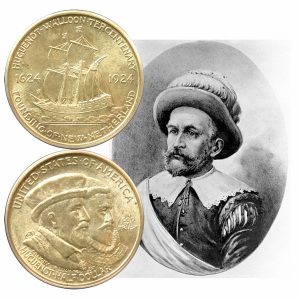Today, the Huguenot-Walloon Commemorative Silver Half Dollar Coin remembers when Pieter Minuit arrived at New Netherlands, now known as Manhattan, 391 years ago.
From the History of the City of New York, 1609-1909 by John William Leonard, published in 1910:
=====
New Netherland was founded by merchants and traders, and throughout the history of that colony and the city of New York, which grew out of it, the commercial interest has been paramount.
Although at the time of the coming of Pieter Minuit, in 1626, the permanent settlement of Manhattan by the Netherlanders had been decreed by the Dutch West India Company, that organization had little care for political or civic theories.
The company was composed of merchants who were after trade, and it was in order to help that trade and give it stability that the colonial project had been formulated.
The Dutch had less incentive to emigrate, at that time, than the people of any other European nation. The religious intolerance which had driven the Puritans to New England and was later to drive the Quakers to Pennsylvania and the Catholics to Maryland, had been banished from the Netherlands, which had achieved such a high degree of civil and religious liberty that every man, whether Jew or Gentile, Protestant or Catholic, or of whatever denomination, was free to follow his conscience as to the mode of worship he desired.
The peopling of Manhattan was, therefore, slow work.
To travel four thousand miles by the slow and tedious methods of the beginning of the Seventeenth Century, with many discomforts and privations, and with poor and scanty fare, for a period of four or five months, was not the kind of thing to attract people from a free and prosperous land such as Holland was at that period.
Even when the voyage was concluded there was not much in the pioneering life to allure people from such sober, comfortable and orderly homes as those of these Hollanders.
Reports which came from New Netherland told of many privations and a scarcity of food, “beans and gray peas” being mentioned as the daily diet of the settlers.
Cultivation of the soil was only possible upon a very small scale, because the horses and cattle of the colony were very few in number, and for the same reason milk, butter and cheese were only obtainable by a few.
Under all the circumstances it is not wonderful the emigrants were few while the country was so little developed, for the inducements were insufficient.
Pieter Minuit, the first director-general of New Netherland, embarked in the ship Sea Mew, from Amsterdam, December 19, 1625.
The endeavor to start the voyage was, however, blocked by ice, and the Texel Channel was not cleared until January 9, 1626, from which time the voyage was made slowly until the final arrival at Manhattan Island, May 4, 1626.
With Minuit on the Sea Mew were the members of his council, Pieter Bylvelt, Jacob Elbertsen Wissinck, John Jansen Brouwer, Simon Dircksen Pos, and Reymert Harmensen.
The first act of Pieter Minuit and his council was to buy Manhattan from the Indians.
The usual method with Europeans in dealing with the nations was to look for what was wanted, and take it.
The Dutch method, as exemplified by Minuit and his associates, was the commercial one.
The sale was officially reported to the Dutch West India Company and by that company to the States-General as having been made for the value of sixty guilders ($24) and that the land conveyed covered eleven thousand morgens, or about 23,100 acres, the Dutch “morgen” being equal to two and one-tenth acres.
The price was not paid in money, which would not have attracted the Indians at all, but in beads, baubles and ornaments of various kinds, and bright colored cloths, of which a vast quantity could be bought in Amsterdam for sixty guilders, and doubtless, both in quantity and quality the consideration seemed adequate to these “wild-men” as they were named in the report of the sale.
There was no writing connected with the sale, but the Indians received the goods, and the settlers entered into possession of the ceded lands.
Besides the director-general and his council there arrived on the Sea Mew, Isaac de Rasieres, Secretary of New Netherland; and the other official, who arrived in July, 1626, was Jan Lampe (or Lampo), who was Schout-fiscal; whose duties comprised not only those now performed by a sheriff, but also that of counsel, both for the prosecution and the defense, in criminal cases.
Another important arrival on the Sea Mew was Kryn Fredericke, a military engineer, who set to work at once, with the aid of the inmates, to build Fort Amsterdam, the walls of which were at first built of earth and faced with sods, but in 1628, before the fort was finished, the walls were strengthened by strong masonry.
Although twenty-four large quarto volumes of documents relative to the history of New York have been collated by Messrs. Brodhead and O’Callaghan and published by the State, there is a singular paucity of archives relating to the administration of the first director-general of New Netherland.
So few were these that for a long time some even questioned the fact that such a dignitary ever held charge of the destinies of New Netherland.
One reason for the scarcity of documents, is the action of a thrifty official of The Hague, who about ninety years ago, finding the place encumbered with what he thought useless documents, sold more than a ton of the West India Company’s oldest papers, in an auction sale of waste paper.
Documents have been found, however, in private hands, which sufficiently establish a place in Manhattan’s history for Pieter Minuit.
=====
The Huguenot-Walloon Commemorative Silver Half Dollar Coin shows with a portrait of Pieter Minuit.
